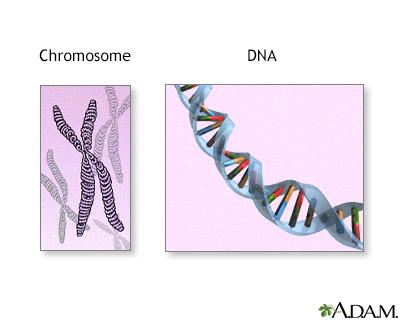Xeroderma pigmentosum
Xeroderma pigmentosum (XP) is a rare condition passed down through families. XP causes the skin and tissue covering the eye to be extremely sensitive to ultraviolet (UV) light. Some people also develop nervous system problems.
Images

I Would Like to Learn About:
Causes
XP is an autosomal recessive inherited disorder. This means you must have 2 copies of an abnormal gene in order for the disease or trait to develop. The disorder is inherited from both your mother and father at the same time. The abnormal gene is rare, so the chances of both parents having the gene are very rare. For this reason, it is unlikely for somebody with the condition to pass it on to the next generation, although it is possible.
UV light, such as from sunlight, damages the genetic material (DNA) in skin cells. Normally, the body repairs this damage. But in people with XP, the body does not fix the damage. As a result, the skin gets very thin and patches of varying color (splotchy pigmentation) appear.
Symptoms
Symptoms usually appear by the time a child is 2 years old.
Skin symptoms include:
- Sunburn that does not heal after just a little bit of sun exposure
- Blistering after just a little bit of sun exposure
- Spider-like blood vessels under the skin
- Patches of discolored skin that get worse, resembling severe aging
- Crusting of the skin
- Scaling of the skin
- Oozing raw skin surface
- Discomfort when being in bright light (photophobia)
- Skin cancer at a very young age (including melanoma, basal cell carcinoma, squamous cell carcinoma)
Eye symptoms include:
- Dry eye
- Clouding of the cornea
- Ulcers of the cornea
- Swelling or inflammation of the eyelids
- Cancer of eyelids, cornea or sclera
Nervous system (neurologic) symptoms, which develop in some children, include:
- Intellectual disability
- Delayed growth
- Loss of hearing
- Muscle weakness of the legs and arms
Exams and Tests
The health care provider will perform a physical exam, paying special attention to the skin and eyes. The provider will also ask about a family history of XP.
Tests that may be done include:
- Skin biopsy in which skin cells are studied in the laboratory
- DNA testing for the problem gene
The following tests can help diagnose the condition in a baby before birth:
- Amniocentesis
- Chorionic villus sampling
- Culture of amniotic cells
Treatment
People with XP need total protection from sunlight. Even the light coming through windows or from fluorescent bulbs can be dangerous.
When out in the sun, protective clothing must be worn.
To protect the skin and eyes from the sunlight:
- Use sunscreen with the highest SPF you can find.
- Wear long-sleeve shirts and long pants.
- Wear sunglasses that block UVA and UVB rays. Teach your child to always wear sunglasses when outdoors.
To prevent skin cancer, your provider may prescribe medicines, such as a retinoid cream, to apply to the skin.
If skin cancer develops, surgery or other methods will be done to remove the cancer.
Support Groups
More information and support for people with XP and their families can be found at:
- National Organization for Rare Disorders – rarediseases.org/rare-diseases/xeroderma-pigmentosum/
- Xeroderma Pigmentosum Society – www.xps.org
Outlook (Prognosis)
Over one half of people with this condition die of skin cancer early in adulthood.
When to Contact a Medical Professional
Contact your provider for an appointment if you or your child has symptoms of XP.
Prevention
Experts recommend genetic counseling for people with a family history of XP who wish to have children.
Related Information
Autosomal recessiveTelangiectasia
Squamous cell skin cancer
Metastasis
Melanoma
Rashes
References
Bender NR, Chiu YE. Photosensitivity. In: Kliegman RM, St. Geme JW, Blum NJ, Shah SS, Tasker RC, Wilson KM, eds. Nelson Textbook of Pediatrics. 21st ed. Philadelphia, PA: Elsevier; 2020:chap 675.
Patterson JW. Disorders of epidermal maturation and keratinization. In: Patterson JW, ed. Weedon's Skin Pathology. 5th ed. Philadelphia, PA: Elsevier; 2021:chap 10.
BACK TO TOPReview Date: 5/31/2023
Reviewed By: Ramin Fathi, MD, FAAD, Director, Phoenix Surgical Dermatology Group, Phoenix, AZ. Also reviewed by David C. Dugdale, MD, Medical Director, Brenda Conaway, Editorial Director, and the A.D.A.M. Editorial team.

Health Content Provider
06/01/2025
|
A.D.A.M., Inc. is accredited by URAC, for Health Content Provider (www.urac.org). URAC's accreditation program is an independent audit to verify that A.D.A.M. follows rigorous standards of quality and accountability. A.D.A.M. is among the first to achieve this important distinction for online health information and services. Learn more about A.D.A.M.'s editorial policy, editorial process and privacy policy. A.D.A.M. is also a founding member of Hi-Ethics. This site complied with the HONcode standard for trustworthy health information from 1995 to 2022, after which HON (Health On the Net, a not-for-profit organization that promoted transparent and reliable health information online) was discontinued. |
The information provided herein should not be used during any medical emergency or for the diagnosis or treatment of any medical condition. A licensed medical professional should be consulted for diagnosis and treatment of any and all medical conditions. Links to other sites are provided for information only -- they do not constitute endorsements of those other sites. © 1997- 2024 A.D.A.M., a business unit of Ebix, Inc. Any duplication or distribution of the information contained herein is strictly prohibited.
